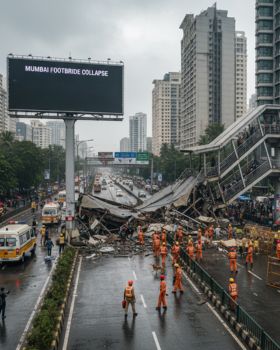
Disclaimer:
The information provided in this blog is for general informational purposes only. While the content draws on historical events such as the Sampoong Department Store collapse to illustrate the importance of contractor safety and compliance, it is not intended to assign legal responsibility or liability to any individuals or entities involved in the incident. Any references to the tragedy are made respectfully and solely to highlight lessons learned in the context of improving modern safety practices. The views and opinions expressed are those of the author and do not constitute professional engineering or legal advice. Readers are encouraged to consult qualified professionals for advice tailored to their specific situation or jurisdiction.
The Sampoong Department Store was once one of South Korea’s largest and most prestigious retail complexes. Located in Seoul, it was known for its modern architecture and wide variety of shopping options. However, on June 29, 1995, this iconic building tragically collapsed, leading to one of the deadliest peacetime structural failures in history. The disaster claimed over 500 lives and left a lasting impression on the importance of construction safety and contractor management.
Today, the Sampoong Department Store no longer exists, but the lessons from this catastrophe remain deeply relevant, especially for industries involved in construction, contractor supervision, and safety compliance.
Understanding What Led to the Collapse
The collapse was not the result of natural causes like an earthquake or weather event. Rather, it stemmed from a series of preventable mistakes involving design changes, construction practices, and insufficient oversight.
Originally planned as a residential building, the structure was converted into a department store during construction. This change involved adding a fifth floor and a heavy rooftop air conditioning system. Unfortunately, these modifications significantly increased the building’s load beyond what the original design could safely handle.
Additionally, some support columns were weakened or removed to make room for escalators and other commercial features. There were signs of distress — such as cracks appearing in the ceiling — but these warnings were not adequately addressed or communicated to workers and management.
The incident highlights the risks when changes are made without thorough structural review and when proper safety protocols are not strictly followed. In particular, the lack of comprehensive contractor management contributed to communication breakdowns and insufficient enforcement of safety standards.
Why Contractor Safety and Compliance Matter
The Sampoong disaster shows that contractor safety is not just about avoiding paperwork or ticking boxes—it is about protecting lives by managing risks systematically. When multiple contractors and subcontractors work on complex projects, the absence of clear safety guidelines and oversight can lead to catastrophic results.
Contractor management involves coordinating many moving parts: ensuring all parties understand the scope of work, complying with relevant safety regulations, and maintaining transparent communication. When these elements fail, the project is vulnerable to errors, delays, or worse, accidents.
While traditional methods—such as paper-based permits and manual checklists—have been used for decades, they can lead to challenges like lost documents, delays in approvals, and lack of real-time visibility into safety status. These issues underline the importance of evolving contractor management approaches.
Modern Contractor Software: What It Can Do and What It Can’t
It is important to set realistic expectations about contractor management software. Such systems do not guarantee accident prevention by monitoring every task or verifying activities in real time. Instead, they serve as tools that facilitate better organization, communication, and compliance by digitizing and centralizing key information.
Contractor software helps companies streamline work permit management, document safety plans, track contractor qualifications, and ensure that required training and certifications are up to date. These features can improve accountability and reduce administrative errors.
However, software is only as effective as the processes and culture around it. The human factor—commitment to safety, proper training, and transparent communication—remains critical. Technology supports these efforts but does not replace the need for vigilance and proactive management on site.
Lessons from the Sampoong Collapse for Today’s Businesses
The lessons from Sampoong are still applicable for organizations managing contractors today:
- Rigorous Risk Assessment: Before any structural change or project phase, assess all risks, including unforeseen impacts on load and safety.
- Clear Communication: Make sure all contractors and workers receive timely and accurate information about project changes and safety concerns.
- Adherence to Design and Safety Standards: Avoid unauthorized modifications and enforce compliance with engineering specifications.
- Documentation and Training: Maintain comprehensive records of permits, inspections, and training to support accountability.
- Continuous Improvement: Regularly review and update safety procedures and management systems to adapt to changing conditions and regulations.
Conclusion: How Contractor Software Could Help Improve Safety and Compliance
While the Sampoong Department Store tragedy was primarily caused by human error and inadequate oversight, the right tools today could help mitigate similar risks. Contractor management software can streamline processes such as work permit issuance, document control, and compliance tracking, helping organizations maintain clearer records and improve contractor coordination.
A well-implemented contractor software system enables organizations to keep better track of contractor credentials, monitor permit statuses, and ensure that safety requirements are met before work begins. This digital approach reduces reliance on paper-based systems, helping minimize errors and delays.
At the same time, technology should complement—not replace—the essential focus on safety culture, training, and proactive communication. Together, these elements build a safer work environment and reduce the likelihood of incidents.
If your organization is looking to strengthen contractor safety and compliance, adopting modern contractor management software could help provide the structure and visibility needed to support safer projects.
🔗 Learn more at sheqnetwork.com and transform the way you manage contractor safety today.
👉 Ready to see it in action? Book your free demo here!
Ready to transform? Contact us today at info@sheqnetwork.com or call us at +353 21 4536034 for a personalized demo!



